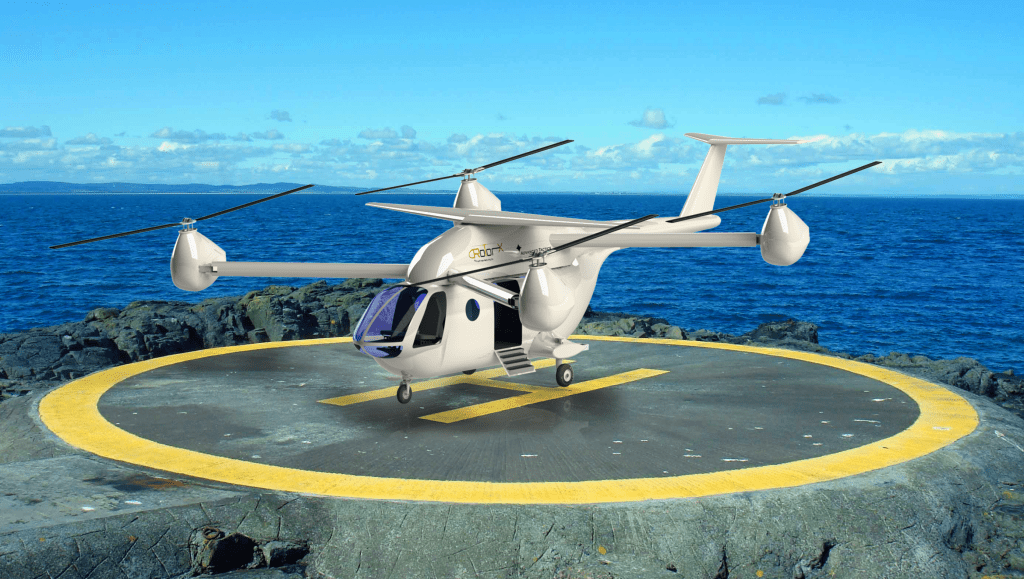Arizona’s Rotor X wants to step up from being the world’s biggest kit helicopter manufacturer and get into the eVTOL game, and to do so, it’s put forth a design it claims is “dramatically more efficient and less expensive than all other eVTOL concepts being proposed or developed today.”
Rotor X’s design is called the RX eTransporter. It’s a relatively simple quad-rotor multicopter, with a helicopter-like cabin that seats up to nine, including pilots, or carries up to 1,600 lb (726 kg) of cargo. These guys are not interested in the complexities of tilt-rotor design or the hover inefficiency of small-diameter rotors; this thing offers four of the biggest rotors you’ll see in the eVTOL space, extended out from the cabin on long poles.
Where most transitioning vectored-thrust or lift-and-cruise eVTOLs rock a large wing for efficient forward flight, the eTransporter has a T-tail and a small top wing. This looks to us like a clever way of compensating for some of each rotor’s retreating blade stall as airspeed increases, but this still won’t be one of the faster air taxis in the sky. Cruise speed is listed at 140 mph (225 km/h), with a max speed “over 160 mph” (257 km/h) – vectored thrust designs are aiming at more like 200 mph (322 km/h).
This is the opposite approach to the ultra-small rotor concept used by Lilium, and its advantages, disadvantages and mission profiles will tend toward the other end of the spectrum. The Lilium jet is horribly inefficient in a hover, but highly efficient on the wing, so Lilium is looking to position itself as an inter-city longer-range transport service.

Rotor X
The eTransporter, on the other hand, will be among the most efficient eVTOLs on the market in a hover – indeed, Rotor X says it’ll be able to hover on the spot for more than 45 minutes if necessary on a single charge. Moving through the air at speed will develop enough lift from the small wings and the body design to double its endurance figure to more than 1.5 hours, and the company is claiming a max range up to 230 miles (370 km) running on battery power. That’s an incredibly impressive figure for a straight-up multicopter, and a testament to just how efficiently larger rotors like this can produce lift.
There are some possible downsides to this approach. One could be noise, which may limit the eTransporter’s ability to operate in densely populated spaces. That said, Rotor X president Don Shaw tells us that the company is currently working on quiet rotor technology. Another is footprint; although plans do call for the propulsion arms to fold up against the eTransporter when they’re not in use, this craft will still take up some space in a vertiport garage.
And then there’s redundancy. Lose one of the rotors and you’ve got yourself a one-way ticket to tumble town. According to Shaw, however, each rotor is powered by multiple motors, one of which can take up the slack if another one fails. Additionally, he claims that the aircraft’s onboard computer stabilization system will automatically compensate if one rotor fails, allowing the pilot to safely land.
Nonetheless, such concerns could prove a pain when it comes to certification, even if the rest of the design is a lot less complex than most of the bigger players in this field; redundancy is the mantra with which other eVTOLs hope to rock the regulators (and their investors) to sleep.
Still, an aircraft tailored toward efficient hovering could make a lot of sense for quick cross-town transport, deliveries and industrial operations. Rotor X says a number of mining companies, for example, are “already showing serious interest” in pilot-optional cargo lift versions of this thing.
The company is working on this project with Advanced Tactics (AT), makers of the Black Knight VTOL “flying truck” for the US Military. AT will be developing a military version of this aircraft as part of the US Air Forces AFWERX/Agility Prime programs. There will also be a longer-range, heavier-lift version built using either a fully combustion-fueled or hybrid powertrain.
Rotor X says it expects to start testing an experimental-class prototype in Alaska next year. It’s expecting commercial FAA air taxi certification by 2024.
Source: Rotor X
Source of Article